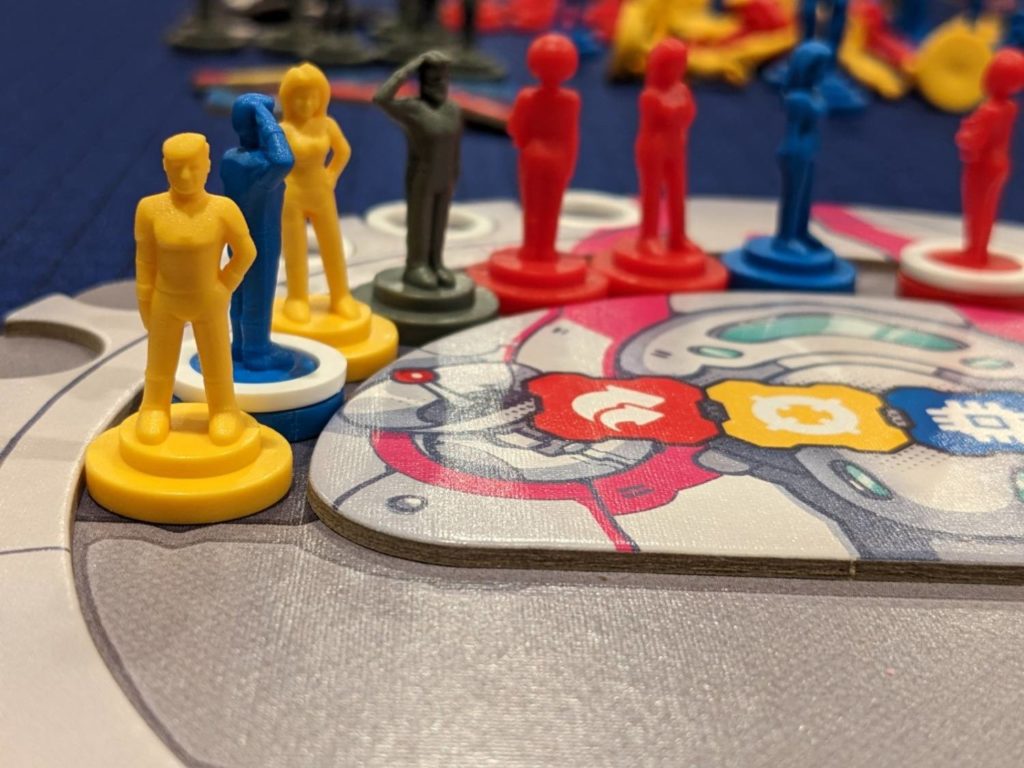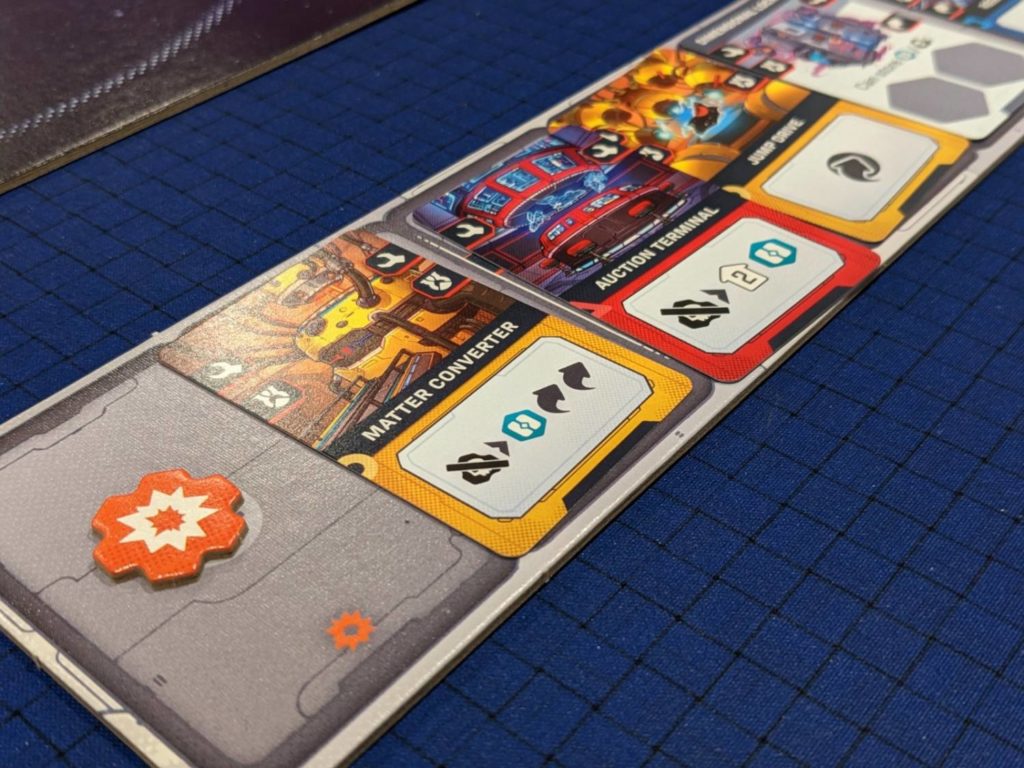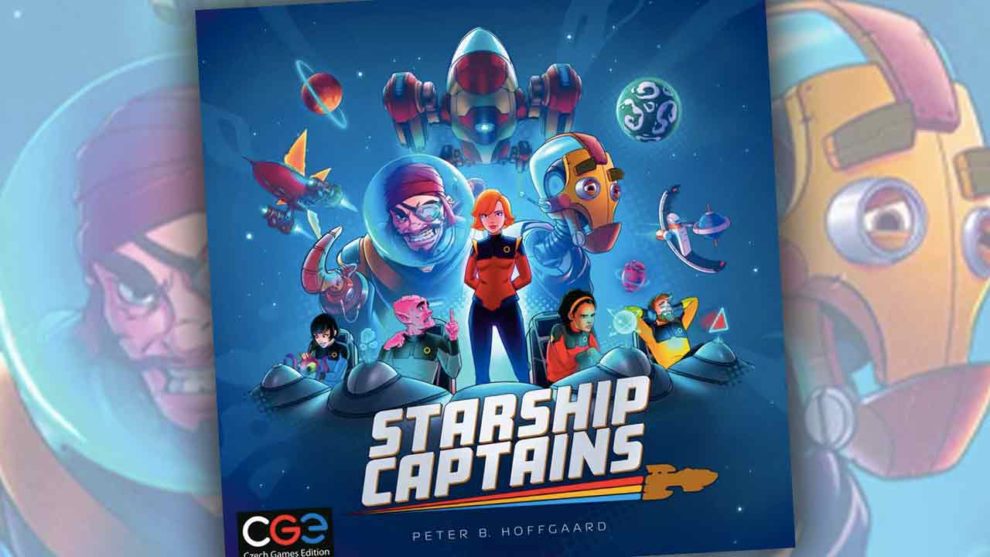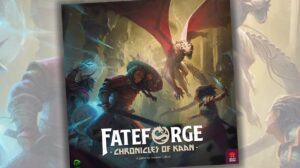Disclosure: Meeple Mountain received a free copy of this product in exchange for an honest, unbiased review. This review is not intended to be an endorsement.
“KHANNNNNNNNNN!!!!”
It’s one of my favorite moments from my favorite Star Trek film, Star Trek II: The Wrath of Khan; Kirk (William Shatner) is baring his teeth and yelling from the bridge of the Enterprise at his longtime nemesis, Khan Noonien Singh (Ricardo Montalban, shamefully not nominated for an Oscar for his work here).
Growing up, I was a Star Trek junkie. Not a Trekkie, but certainly a junkie.
You know who else is a Star Trek junkie? Peter B. Hoffgaard, the designer of the new Czech Games Edition title Starship Captains. From the cover art, to the very Enterprise-looking player boards, to easter eggs like a mission called “Roddenberries”, everything about Starship Captains screams “play this if you love Star Trek.” As a junkie, I was thrilled to give this one a spin.

The Bridge
Starship Captains puts players in control of Enterprise-like starships working together in the faction known as the Cooperative (in part because I’m guessing “Federation” was taken!). Recently promoted to the rank of Captain, each player has command of a small crew of specialists from across the universe.
These specialists are your workers, and you will place them in different departments of your ship and your tech board to take actions. (I won’t call this a worker placement game though, because these spaces are available to all players on their various ships, then the spaces clear at the end of each turn.)
Your workers are cadets (gray figurines which represent unskilled labor, only capable of taking repair actions when first recruited) and ensigns. Ensigns are specialized by color: red ensigns fly the ship, yellow ensigns coordinate weapons systems, and blue ensigns are your technical experts.
The shared main board of Starship Captains represents the galaxy, with a slightly larger selection of locations on the four-player-only side of the board. (The reverse side is for 1-3 players.) Using a single crew member to take an action, each turn allows players to activate a department (known simply as a room) or complete a mission at the planet where their ship is currently docked.
Starship Captains is easy to teach because of the color coding of actions (and the symbols of each action help with accessibility) and the simplicity of turns. You will take a crew member from the “ready room”—the ship’s bridge, in one of my favorite parts of the game’s production—and do something to activate a room for many of your turns. Yellow and red are very straightforward actions, available to ensure you always have the ability to take out any pirates on the routes connected to your current location, or to move.
The basic blue action is to research technology, and the variability of the tech market is the game’s best feature. Taking a technology from the market of eight cards doesn’t cost a thing, and the tech is added to a tech board with six available slots. Over the course of play, adding technologies gives you three different options:
- Omega techs are end-game scoring conditions, with only three of them available when play begins
- Room techs can be activated as normal rooms later by a matching crew member, and each of these unique cards give your crew better options beyond the four basic rooms you have on the bridge of your ship
- Ability techs are ongoing powers that trigger during play
To begin play, four of the six slots on this tech board are unavailable because they are damaged (your promotion to Captain only provided you with a “newly refurbished” ship, per the manual), so you’ll have to spend some of your actions removing damage from both this board and the ship’s cargo area. The cargo area is used to hold pirate tokens you’ve defeated on earlier turns (maybe they are prisoners being returned to the Cooperative’s headquarters?) as well as artifact tokens, which can be used to activate rooms without a crew member.

Tech, No Trees
The technology board is my favorite part of Starship Captains, because it changes how each game will play out. It is fun to try and grab the Omega techs to boost endgame scoring.
Having options for rooms can be key. Some cards break the idea that only red ensigns can fly the ship, so in a game when I added the Jump Drive tech card to my board, this gave me more options for my yellow ensigns. Ability techs boost all the other actions, so combining some of these led to different approaches to taking on missions.
Missions are the heart of the game’s scoring. If you aren’t taking actions on a turn, you are completing missions—there are always at least five missions scattered across the universe to choose from. Flying to a planet before anyone else arrives ensures that the player will have first dibs on completing that mission. As a turn’s main action, you will have to assign crew members to the mission (never more than one of each of the game’s three ensign colors) and try to complete them.
If you match up the crew member color with the mission line color, you’ll get a reward (and possibly a penalty) for that line. For example, a mission might require a red ensign and a yellow one. You could use a cadet and a yellow ensign to complete the mission, but you’ll only get the bonus for the yellow line. That also means you’ll avoid any penalties that might align with the red section of the mission.
Making missions this easy to complete—in terms of teaching how to complete them—is what made Starship Captains enjoyable. All the actions are easy to understand. This is helped by the stellar assistance of the player aid, which reminded me a lot of the aids included in Lost Ruins of Arnak, another CGE production. Almost everything in Starship Captains is described on the player aid, including crew definitions, what medals can do, and all the iconography listed on cards and faction tracks.
PUBLISHERS: please, please, please, you’ve got to include player aids with your games if the iconography is even a minor challenge! Why are we still talking about this on the eve of 2023?????

Go, But Maybe Not So Boldly
I would contend that games like Starship Captains, similar to First Rat and other very approachable recent designs, are fantastic ways to introduce gamers to the hobby. The concepts in Starship Captains are easy to grasp, yet for experienced gamers there is still a lot to initially enjoy when trying to min/max each turn.
Playtime was consistent with the information on the side of the box: my first solo game took 30 minutes, and that was because I needed to constantly refer back to what each icon on the solo cards would do. (Solo? It’s fine. Use it as a teaching tool then move on.) My next two three-player games took 75 minutes and 60 minutes. My only two-player game took an hour including the teach. With someone newer to gaming, I could see a three-player game taking 90 minutes; with experienced gamers who take quick turns, the whole voyage will wrap in under an hour.
The production is mostly a winner. The best tactile part of the game comes when you need to slide your crew members around a small, indented wheel at the top of your player board. Even better: only crew members fit in that wheel. Try to slide an android meeple around this wheel, and it doesn’t fit, a reminder that androids—a wild worker type—have to be discarded when completing missions. Love it!
Turns are quick, so downtime is low. The player aid has everything you need. It’s fun to plan out turns because the game is definitely a race to complete missions, but there are still plenty of backup options if another player beats you to the most desirable planet.
Medals allow players to train any of their cadets or ensigns to another color; pay three medals and you can upgrade an ensign to a commander, which allows for the commander to do double actions or command a crew member of the same color to come out of the waiting area onto the ready room of your ship.

Ultimately, It’s the Scoring
Now, as much as I’ve enjoyed Starship Captains, I have to admit that I’m already done playing it.
After three multiplayer plays and four solo plays (I was able to do two of those solo plays over a recent lunch hour), I’ve seen all that Starship Captains has to show me until expansion content hits in a year or two. (CGE has not confirmed this, but let’s just say I have a sneaking suspicion.)
The game’s first two rounds usually look the same because you won’t have many ensigns to work with yet. All players take the same tack that I take when looking at the board: if there is a 6- or 7-point mission within range, I will move my ship there and complete it on my next turn. (Seven points is the max for any one mission.)
The Trek-ish theme drew me in, but the gameplay has less punch. It is steadily enjoyable but it is never thrilling. You may have a turn where you complete a mission that pushes you up on maybe two different tracks, and those single bumps net you a single repair and a medal. That’s OK, but you would stare at another player who pumped their fist as they completed a turn like that.
Replayability is limited so manage expectations accordingly. I had much more fun with my first two plays than my last two plays.
I’m more intrigued by the scoring in Starship Captains.
The game’s manual provides fun flavor text for each specific possible score from 21-75. 0-20 is summarized with something to the effect of “you are terrible at board games”, and I agree—it feels like it is almost impossible to score less than 25 points. The lowest score I have seen is 28 points, but the highest score across seven plays was 39.
Those scoring concerns go further. The game’s faction tracks—which are pretty boring to begin with—offer a way to boost scores and trigger in-game events, events which are quite minor. Going around even one track a single time is nearly impossible in this game and something I saw only when players specifically took missions only to go up on a single track.
But there’s a 5-point bonus available to any player who goes around any single track twice. I don’t know how it is possible to go up a single track twice during this game’s short four-round format.
Another example: five commander rings are available to each player. These rings signify when you’ve achieved a promotion. The highest total number of commanders I’ve seen promoted by a single player is three. In that game, one player had a tech which allowed them to train a certain color of commander with only two medals, instead of the normal three.
But let’s play out a perfect-world scenario: you are able to pick up, say, the Security Suit tech which allows you to promote yellow ensigns for two medals. You get that tech on your very first turn of the game. Even if you are able to gather a few medals through missions and also line up your techs to get the bonuses on your tech board, you are probably not getting ten medals over the entire game.
Further, you only get this discount on yellow ensigns, and you never add new ensigns by color, only cadets. So you still need one of the techs that allow you to train cadets to yellow ensigns for free (Blast-Phasers). So, if you strike gold and add both Blast-Phasers first, then Security Suit second, then still get 10 medals during the course of the entire game, you might promote five ensigns to commanders.
But that would be a miracle. Why are there so many rings slotted on each player board for a miracle scenario like this?
It is these issues that give me pause. I think Starship Captains will land best as a game played with casual players, and played only occasionally. Playing it once every few months is perfect, and lets players who arrive mainly for the theme take part in a medium-light gaming experience that is simple to teach.
For core gamers, I think Starship Captains will be average fare. There may be ways to house-rule some of my concerns by letting players take bigger jumps on the tech track (one bump should be one bump up through a zone, not a single space, making lapping the track much easier) or providing a starting tech to each player to help drive their strategy.
I think Starship Captains is one expansion away from greatness. As is, go, just not as boldly as I was hoping!











Kirk wasn’t on the bridge of the Enterprise when he shouted Khan’s name.